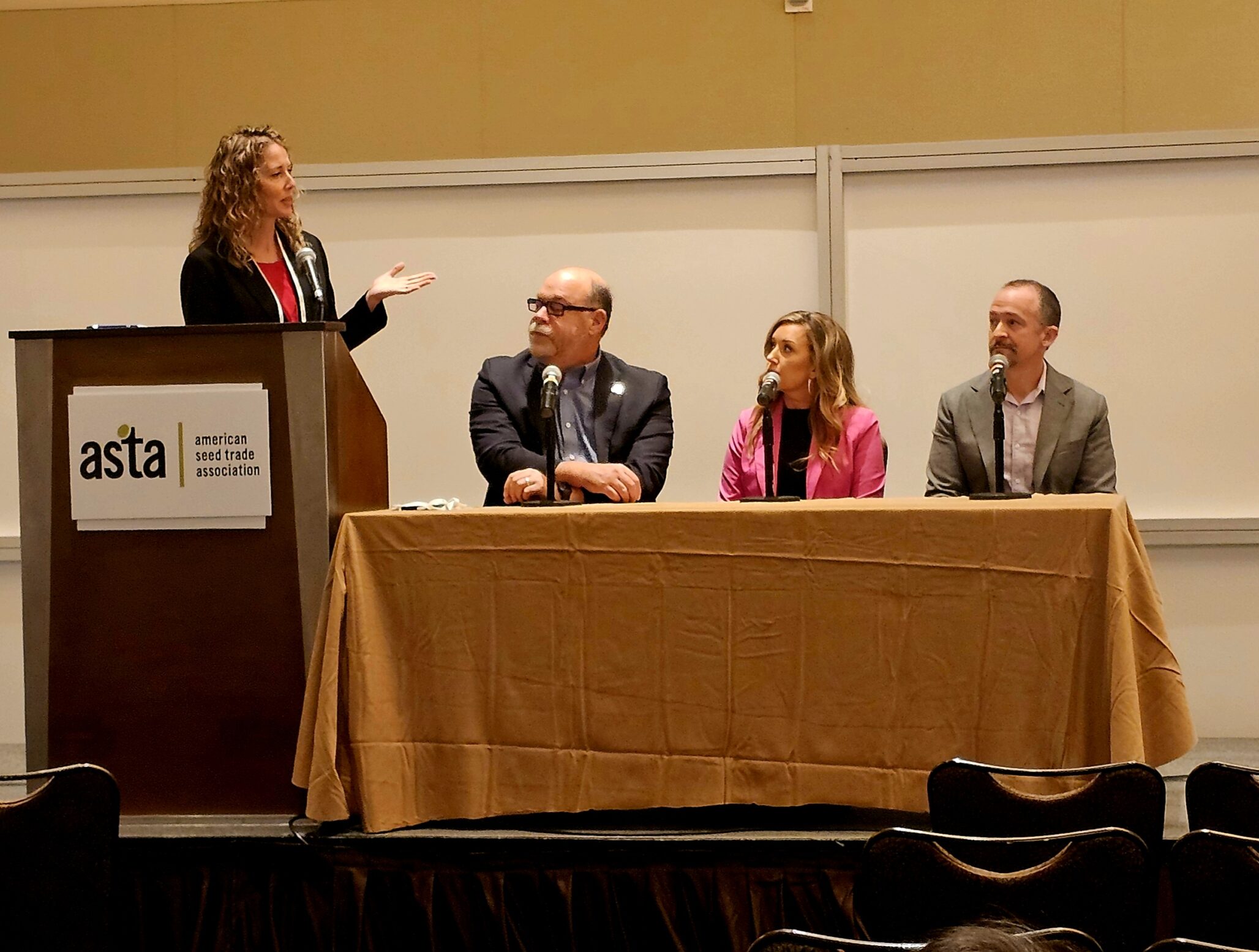At this year’s American Seed Trade Association Field Crop Seed Convention, Seed World Group hosted a live panel discussion about how we as individuals, companies, associations, and the collective seed industry can build more influence, meaningfully leverage advocacy, and more effectively share the seed industry story.
Moderator Madeleine Baerg (Seed World Group’s director of content) was joined by Ian Miller, the chief development officer of Pairwise; Sarah Wilbanks, CEO of the Association of Official Seed Certifying Agencies (AOSCA); and Marc Cool, the global seed policy lead at Corteva.
Two realities are clear in the seed industry’s voice today. One: the seed industry has an incredible story to tell. In small and giant ways, it is front and center on solving many of the world’s biggest challenges.
However, the second reality is that the seed industry doesn’t always do an excellent job of telling its own story. In fact, the seed industry story that consumers, policy makers, job seekers, and the general public hears is often shaped — even controlled — by outside voices.
As an industry, said Wilbanks, “we’re very good at doing what we’re doing, but we’ve not done a good job of telling people about it.”
The seed industry has also sometimes not looked at the end goal of messaging strategies.
“One of our theories is that, unfortunately, biotech ended up with a little bit of a bad name because we felt like it didn’t make as direct a benefit to the consumer. It certainly benefits other parts of the chain, but that indirect benefit wasn’t enough for the consumer,” said Miller.
Without the seed industry actively promoting the benefits to the consumer, it became easy for the technology to be misunderstood and vilified. If the seed industry wants the license to operate with biotech or other new innovations, and if it wants to draw the kind of people it needs to be effective into the future, it needs to better showcase the public good, from local to global, that it does every day. Advocating effectively and building influence are pivotal parts of getting that story heard.
A shift is underway in the seed industry, however.
“I sense a very positive, good, necessary shift,” said Cool. “Rather than us as an industry in the food production system defending the technologies we use – the use of biotechnology, now gene editing, mutagenesis (which some people question), chemistry, water… rather than defend that, we need to shift towards: so what’s the benefits? What is the product that you’re developing that you can actually eat and that pleases you and that gives you as a human nourishment and pleasure and all the other factors that you’re looking for? I think that shift is happening, [moving] from defending technology to talking about how technology enables the delivery of value and benefits to humankind. And that to me is an exciting time.”
Miller’s company is an industry innovator that uses new breeding technologies, including CRISPR, to create better tasting, higher nutrition, more convenient produce, ultimately with the mission of promoting healthier eating habits. PairWise recently launched a line of salad greens called Conscious Greens: a mustard greens salad that has been genetically engineered to remove the strongly pungent horseradish flavor of mustard greens, while retaining all of that crop’s nutritional benefits.
“Food is a very emotional experience for people. We think if we can make a connection with people, we can really ease adoption of this technology,” said Miller.
For example, his team recently took their salads to three different events in three cities. Over the visits, they explained the health benefits of their product, served 6000 portions, then collected surveys back from about half of the taste-testers.
“What we got [from the surveys] was a very high willingness to buy it. Less than 1% said anything about the technology, and [we] specifically asked about that. So to me, that speaks to the power of connection, because it’s not a narrative we were driving… We’ve made that connection with those consumers and they’ve accepted it for what it is, providing them benefit.”
His take-away message to the rest of the seed industry? Be authentic, lead with the benefits, be transparent and try to make a connection.
Arguably the lowest hanging fruit opportunity for the seed industry messaging is social media. Though it’s been an avenue agriculture as a whole has not widely embraced, Wilbanks said the seed industry needs to invest more deeply in social media.
“40 or 50% of the American population gets all of their news off of their social media feed. That’s quite concerning,” said Wilbanks. “But it really goes to show you if we don’t meet people in those mechanisms, and at those levels, we’re really just not going to get as advanced with [where we need to go]… We all somehow in our business models need to put some pieces of that puzzle together to help the overall mission.”
Though almost anyone in the seed industry would agree it’s critical that we build the seed industry voice, it’s very easy to slip into thinking that it’s someone else’s responsibility to carry that weight.
“I think we all have an obligation to engage in these conversations,” said Miller. “I think we all have different stories to tell… and I think [those stories coming from multiple sources] can be mutually reinforcing between different folks in the industry.”
Most importantly, the panel talked tools: the concrete strategies that we in the seed industry can use, regardless of where we fit into the seed value chain, that will allow each of us to better contribute to building the seed industry’s voice.
“We need to understand that the conversation we’re having with greater society is a never-ending dialogue,” said Cool. “We’re never going to reach a conclusion where society gives us a certificate that we can put on the wall that says: ‘Okay, you have freedom to operate. We trust your technology. It’s good.’ That discussion is ever evolving, ever ongoing. So the strategy we have is to open ourselves up to have that discussion knowing that the discussion doesn’t result in a really nice black and white, yes or no.”
In the late ‘80s and ‘90s, many people began mistrusting biotech because they didn’t understand what it was.
“We forgot as an industry to explain the benefits of that technology. So now what we’re saying is: we will be transparent about what we’re doing, knowing that not everyone will agree, but that’s okay because we’re having a conversation,” said Cool. “The conversation then highlights and clarifies what everyone believes in and then we can work towards those common beliefs.”
Wilbanks said a huge impact could be achieved by a relatively small overall investment by the seed industry.
“Take 1% of your time and your staff time in 2024 and try to really push out the messaging … to tell your story. We’re all very, very busy. But if you put that in your strategic initiatives for the year, and you really make that a priority — if we all did that — what kind of messaging and what kind of impacts could we make?”













